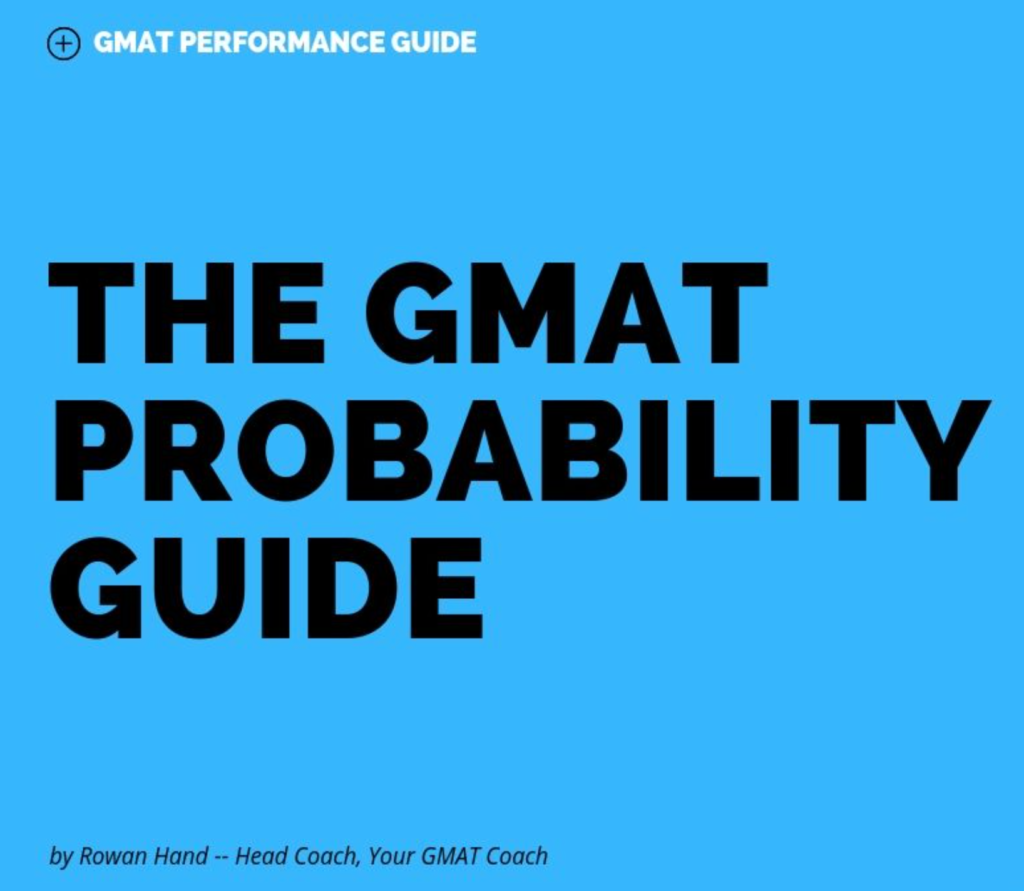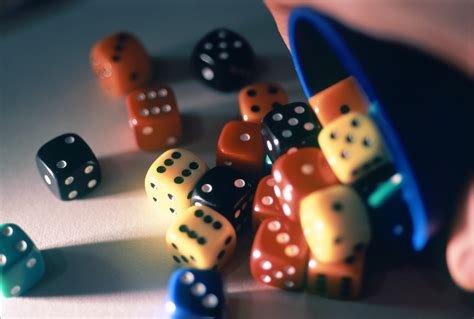GMAT Probability and Number of Distributions x Probability per Distribution
The Independent Probability Case for GMAT Probability
Now, let’s go back to the example from the previous page, which we can rephrase as this:If a coin is flipped five times, what is the Probability that it will land on Heads only once?That gives us a situation in this form, as we saw previously:
HTTTTT
The appropriate way to deal with something such as this is to split it into two parts: first, consider how many ways we could select one Head and five Tails. You don’t need to count them all out by hand, of course.
In this case, it’s easy to see that the H could be in the first, second, third, fourth, or fifth position. We just don’t know which. That leaves us, of course, five possibilities. In situations where you can select your desired outcome in multiple ways, we need to consider the number of ways it is possible to achieve this outcome.
This would be, in this example, the ways that we can choose one Head. Let’s call it the Number of Distributions.
Thus far, we have:
Number of Distributions: 5
Now we need to concern ourselves with the Probability per Distribution. This is actually quite straightforward, comparatively. All we need to do is to take one of the potential outcomes (they always have the same Probability, but we’ll address this in more detail later) and figure out its Probability:
HTTTT
(1/2)(1/2)(1/2)(1/2)(1/2)=1/32
Now of course we know that the Number of Distributions is 5. All we need to do now is multiply the Number of Distributions by the Probability per Distribution and we get our Probability:
Number of Distributions ProbabilityDistribution=Probability
That is…
5 * 1/32= 5/32
We see that in five out of our 32 possibilities, only one Head is expressed. This type of question might seem a bit too easy because the Coin Toss scenario clearly implies Independent Probability.
Let’s take a look at a Dependent Probability case and see how that switches things around…

The Dependent Probability Case for GMAT Probability
Dependent Probability comes into play when we look at situations where we’re not recycling each turn. A simple case would look like this:
Out of a box of seven light bulbs, three are defective. If two light bulbs are selected from the box, what is the Probability that exactly one of the two is defective?
Let’s start with the number of distributions: that’s actually just two. Using “D” to mean defective, that gives us:
P(D)*P(-D)
or
P(-D)*P(D)
Now, if this seems a little bit confusing–after all, multiplication should be commutative–remember that we are looking at two exclusive, hypothetical circumstances.
That is, either we pick the defective bulb first and then pick the non-defective bulb or vice-versa (non-defective then defective).
This is easy to count by hand, but in the next section we’ll address what to do in situations where the numbers get a bit more complicated.
Moving on, let’s look at the Probability for each of the options. Remember, it should be the same–ideally you would just take one of them and work with it.
P(D)*P(-D)
(3/7)*(4/6)=27
OR
P(-D)*P(D)
(4/7)*(3/6)=2/7
Note again that the denominator should count down the same way as always, but that the numerator will be rearranged in each case. This is a great example of a circumstance where we want to apply the fact that multiplication is commutative.
Now, remember that we select the defective bulb either first OR second. We can’t select it both times, yes? That means that the situations are exclusive.
It follows that our Probability is thus the Probability of selecting the defective bulb first PLUS the Probability of selecting the defective bulb second.
That is,
(P(D)*P(-D))+(P(-D)*P(D))
2/7+2/7=4/7
A Note on Using Combinations to Solve Probability Questions
If you dislike Combinations or don’t understand nCr notation, please feel free to skip this.
I’m going to gloss over how to calculate a Combination here because it’s outside the scope of this book. Quite honestly, I don’t tend to use Combinations to solve Probability questions for one simple reason:
Any GMAT Probability question that can be solved using Combinations can be solved with less mental effort by using the Distributions x Probability/Distribution method.
What do I mean by “less mental effort?” Simple: the Distributions x Probability/Distribution method doesn’t really require a lot of thinking or planning on the part of the testtaker. It provides a simple framework that we can use for this ultra-common type of Probability question.
Combinations, on the other hand, require us to focus quite intently on how we would select the desired outcome, which would have to be done from scratch every time. Mercifully, the total outcomes are as straightforward as ever to calculate. Let’s look at an example done each way to illustrate the difference:
If a committee of three people is to be selected from among three doctors, four lawyers, and five accountants, what is the Probability that exactly two of the three people selected for the committee will be lawyers?
Method 1: Distributions x Probability/Distribution
First things first: we have 3+4+5=12 people total.
Now, let’s figure out the number of ways that we can select three lawyers:
P(L)*P(L)*P(-L)
Note that we could select the “not-Lawyer” either first, second, or third. This means that there are three distributions.
Now, we simply take one of those three–remember, the Probability per Distribution should be the same for each:
P(L)*P(L)*P(-L)
4/12*3/11*8/10
Or
1/3*3/11*4/5=4/55
Now that we have the Number of Distributions and the Probability per Distribution, all we need to do is multiply them:
Number of Distributions * Probability/Distribution= Probability
3*4/55 = 12/55
And here, before I forget, are the rest of the GMAT Probability resources…
Method 2: Combinations
Arguably, this looks easier.
Hell, if it is easier for you, just do it this way. I maintain that it makes my brain stretch harder, but that doesn’t mean it won’t be a better fit for you. Whatever gets the turkey perky, eh?
Let’s start with the total number of ways that we can choose three people from among 12 (I’m writing this all with Slot Method because I am not a masochist):
12C3
or
(12*11*10)/3! = 220
Looking pretty healthy: note that 55 is a factor of 220, so I reckon we’re on the right track.
Now let’s think about the ways that we can select two Lawyers and one not-Lawyer. This needs to be broken into two Combinations:
For the Lawyers, we get 4C2 because we have four Lawyers from whom we choose two.
For the not-Lawyer, we get 8C1 because we have eight not-Lawyers from whom we choose one.
All we need to do now to get the desired outcomes is to multiply these two numbers. Note that in this case, the order of selection won’t matter.
4C2*8C1
((4*3)/2!) * (8/1) = 48
Of course at this point, we just divide the desired outcomes by the total outcomes. That is…
48/220=12/55
Unsurprisingly, given the beginning of this section, it’s possible to do these questions either way. Take your pick.
How to Find Distributions Easily: the “Mississippi Rule”
If you’re in a situation where you need to find the number of distributions for a set that’s not small enough to count by hand–or if you’re just feeling lazy, of course–then this is the trick for you!
The “Mississippi Rule” is a useful mnemonic for remembering how many ways a group that has repeated terms can be arranged. It all stems from this example: How many ways can the letters in the word “Mississippi” be arranged?Let’s start by counting the letters in the word Mississippi.
That’s right: there are eleven of them. If these were all different letters, that would mean there were 11! ways to count them.
The problem with this, of course, is the fact that our Ss, Is, and Ps are all stated more than once. Let’s look at the simplest example, the Ps. There are two Ps that are counted as exactly the same, so if we account for this (by dividing by 2!), we actually have half of the possibilities that we originally thought. That is…
11!/2!
That’s taking care of the Ps, of course, so let’s take a look at the Ss: there are four of these, so we can account for the repeated terms by dividing by 4! as well. That is…
11!/(2!4!4!)
Then, of course, we can do the exact same thing to account for the Is. Again, the term is repeated four times, so we can divide by 4!. That’s our final value, which is not actually worth calculating.(OK… it’s acutally 34650). EVEN SO, the final value isn’t as important as the basic idea, which is the factorial of the total divided by the factorial of each repeated term:
total!/(repeated!repeated!repeated!)
Yup. Simple as that.
But not as simple as finding all the GMAT Probability Resources in one place!
Complicating the Situation of Distributions x Probability/Distribution
You wouldn’t expect it all to be that easy, would you?Hmm… probably no. How could this become more difficult? There are a couple of ways, which we’ll examine here.
The fundamental structure is exactly as we’ve discussed:
number of distributions x probability/distribution.
Nevertheless, the initial step of figuring out the number of distributions can be complicated somewhat by any particular fuckery that the testwriter chooses to employ.
Example 1:
A bag contains three black balls and three white balls. If four balls are pulled from the bag, what is the Probability that more black balls than white balls are pulled from the bag?
Hrm… well… let’s look at this in a bit more detail. Start with the question: How do we know what constitutes “more black balls than white balls?”
A cursory examination, of course, will lead us to recognize these basic facts: first, four balls is more than either total; second, this implies that the only situation wherein more black balls than white balls are pulled is the situation wherein three black balls are pulled and one white ball is pulled.
This yields a situation that can be notated as such:
BBBW
Note that this is a classic “Mississippi” situation, where we can easily see that the number of distributions is: total!repeated!=4!3!=4
Simple as that. Our number of distributions is 4.
Now, let’s calculate the Probability per Distribution. Remember that we can take any of the potential distributions, because they represent the same circumstance with a simple rearrangement of order.
In other words, it’s the same shit, different day.
BBBW
(3/6)(2/5)(1/4)(3/3)=120
Then our answer is as simple as…number of distributions probabilitydistribution=4120=15And that’s that. For extra credit, try to solve this one using Combinations! As I said, it’s your funeral.
Dependent Probabilities with Distribution and Exclusion
Whew! That sounds scarier than it needs to be.
These problems are among the most challenging Probability questions that the GMAT will present, but they’re still quite accessible.
Let’s take a look at an example:
Ralph is playing a game where, during each turn, he throws one of four balls into one of four boxes. Each of the balls are colored red, yellow, blue, and green, respectively, and has a corresponding box of its color. If Ralph takes four turns, landing one ball in each box, what is the Probability that only one ball matches the color of its box?
OK, that’s a lot to chew on, but let’s start with the basics. Let’s say that we get the first ball into its corresponding box, which we’ll call C for “correct.” Then the other three will be, of course, -C or “incorrect.”
Then we’re looking at a situation such as this:
P(C)*P(-C)*P(-C)*P(-C)
Applying Mississippi, we can see that the C can be in this many places: 4!3!=4. Or, if you’re so inclined, just notice that the C can be in the first, second, third, or fourth position. Either way, it’s four possibilities, yo.
Now all we need to do is take a sample of one of these four–remember that any of them will do!–and figure out the Probability per Distribution.
Notice that if we put the Correct ball/box combination first, we’ll get Probability of 14. That’s straightforward, of course. Things get slightly weirder with the other three choices: just think for a moment about how many not correct options exist for the second choice. There are three balls to choose from: two are not correct and one is correct.
That means the Probability for the second choice is, of course, 23. Then the third choice is 12, and of course the fourth choice is the only one that’s left–which, at this point, MUST BE not correct. That, of course, presents us a Probability of 11.
P(C)*P(-C)*P(-C)*P(-C)
(1/4)*(2/3)*(1/2)*(1/1)=1/12
Bear in mind, of course, that this is only one of our four potential distributions. The ultimate Probability is:
number of distributions * (probability/distribution) = 4*(1/12)=1/3
Take a deep breath. It gets easier from here on out. Let’s look at the next common type of Probability question.
Like what you’ve seen here? Check out the GMAT Probability Guide here.






